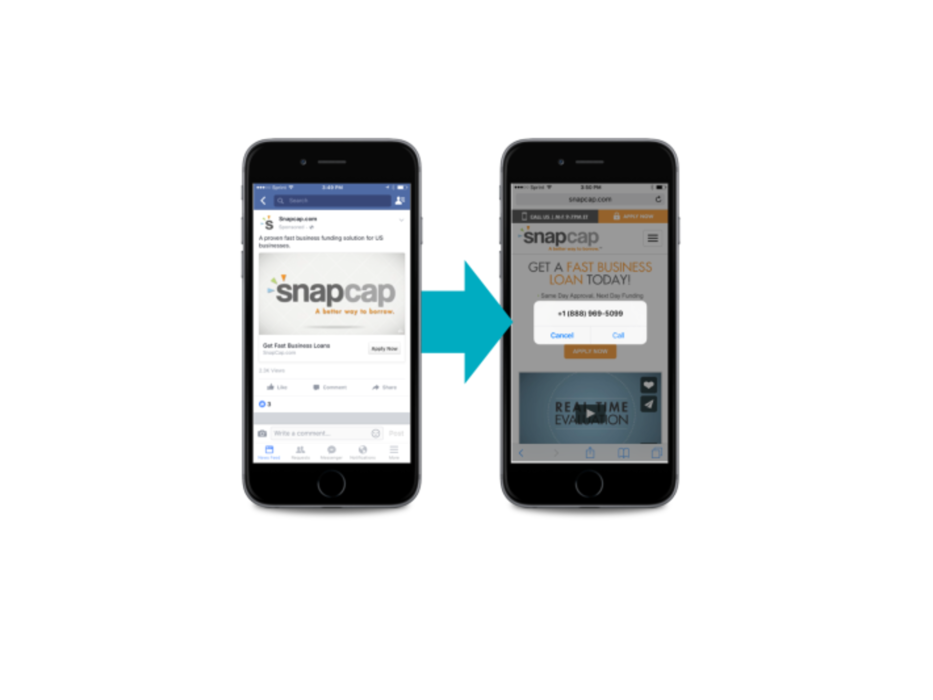In the marketing world, not every channel pulls equal weight. Some are key engagement drivers while others are prime converters. Small business loan provider SnapCap wanted to find out which channels were driving inbound calls to its main line. So, it employed the help of call attribution software provider DialogTech to find some answers and adjust its budget accordingly.
Calling for help
As a small business loan provider, SnapCap targets companies that are at least one year-old and generate a minimum of $100,000 in annual revenue. The organization uses display, search, and social media to lure borrowers into filling out an online application or calling SnapCap directly. The latter of the two is the preferred situation, considering that SnapCap’s representatives need to speak to prospects over the phone before giving out any loans.
“If the customer is calling us first, it’s just an added bonus for us,” says Mack Johnston, VP of data and analytics for SnapCap. “It’s one of the most valuable conversions for us.”
SnapCap’s marketers wanted to know which channels were driving the most phone calls, allowing them to adjust their resources accordingly. So in January 2016, they implemented DialogTech.
Dialing into the data
DialogTech integrates with CRM system Salesforce to attribute inbound calls to the appropriate channel and track the customer journey the rest of the way through. Here’s how Blair Symes, DialogTech’s director of content marketing, says it works: When a prospect clicks on an ad and travels to SnapCap’s website, DialogTech automatically replaces the standard phone number on SnapCap’s site with a unique, trackable phone number—one that follows the prospect throughout the remainder of his site visit. That way, if the prospect ends up making a call, SnapCap can identify which channel he came from and discover other contextual information.
Say a lead calls SnapCap after clicking on a Google search ad that led him to the SnapCap website. Not only can SnapCap identify that the lead came from Google, Symes says, but it can also recognize the keywords associated with that ad, as well as the path the lead took throughout the website that led him to call. In addition, it can see where the lead is calling from, who the lead is, and that lead’s phone number. And because the technology is integrated with Salesforce, Symes adds, SnapCap can determine whether that lead is actually an existing customer and pull up his history—giving the sales staff the data it needs to have a more relevant conversation (i.e. who is calling and what drove him to call). The integration also enables the loan provider to track whether the lead ends up converting.
“As a marketer, it’s great to know which sources generate the most leads, whether that’s calls or leads online ([like] filling out an application form on your website),” Symes says. “But at the end of the day, you really want to be able to know which marketing sources generate actual customers.”
Ringing in the results
By May, SnapCap had increased its calls-per-month by 30%. This figure has since risen to 68%.
“We’ve been tracking the calls and we’ve been able to allocate budget to services that have been able to drive more call conversion—instead of just general inquiries—which has really helped our sales team,” Johnston says.
It appears that some channels are better at driving calls than others. For instance, Johnston and his team suspect that people who are actively searching for business loans online tend to have fewer questions—and therefore are more likely to fill out an online application—while prospects who come across an ad via social or display have more questions and are more likely to call the company directly.
Still, driving conversion via mobile remains a challenge for many marketers, including SnapCap. Johnston says the company has made investments to optimize its website and urge those on mobile devices to call, instead of complete a form.
“Now, with smartphones, it’s amazing how many people prefer to call as opposed to fill out a Web form on their little smartphone,” Symes says. “It’s a pain. So, calling is so much easier [and] it’s so much more immediate.”
And when measuring campaigns in today’s digital world, Symes says marketers can’t forget to track the phone.
“In this era of omnichannel, cross-channel marketing, the phone part is just as important as measuring the online part or even the in-store visit part,” he says. “It’s just one of the three big omnichannel conversion paths that marketers need to control and own in 2016.”








